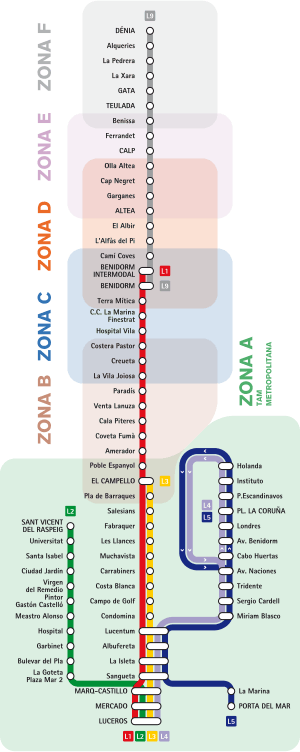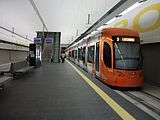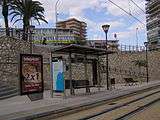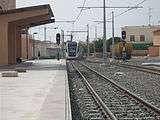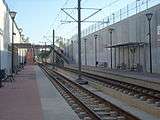Alicante Tram
The Alicante Tram, trademarked as Alicante Metropolitan TRAM (Valencian: TRAM Metropolità d'Alacant, Spanish: TRAM Metropolitano de Alicante),[lower-alpha 1][lower-alpha 2] operates in the Spanish city of Alicante (Valencia) and its surrounding area. Like other narrow gauge railways in the Valencian Community, it is run by Ferrocarrils de la Generalitat Valenciana (FGV). It was inaugurated on 15 August 2003 replacing narrow-gauge diesel trains between Alicante and El Campello.
 | |||
| Overview | |||
|---|---|---|---|
| Locale | Alicante, Valencia, Spain | ||
| Transit type | Tram Tram-train Light rail Light metro Commuter rail | ||
| Daily ridership | 33,126 (avg. weekday, 2019) | ||
| Annual ridership | 12,091,192[1] (2019) | ||
| Website | www.fgvalicante.com | ||
| Operation | |||
| Began operation | 1999 | ||
| Operator(s) | FGV | ||
| |||
The Alicante Metropolitan Tram light rail combines different modes of rail services: a partially underground modern tramway through Alicante city centre, a tram-train from Alicante to Benidorm, and conventional commuter rail from Benidorm to Altea, Calp and Dénia.
History
There has been a rich history of urban rail service in Alicante. The tram service began on 13 July 1893 and the network was rapidly expanding to Mutxamel (1902), Elche and Crevillent (1905) and San Vicente del Raspeig (1906). Initially, the streetcars were horse-drawn. Since 1903 the trams were carried as well by the power of steam engine, leading to the disappearance of the horse-drawn trams by 1924. The electrification of tram lines began in 1923. In 1920s and 30s the network was further expanded throughout the city and was extensively used in 1940s. In 1950s, due to high costs of electricity, trams were gradually losing the competition against growing automobile services and by 14 November 1969 they completely disappeared from the streets. Thirty years later, on 13 March 1999 the trams were back with the inauguration of an experimental route between Plaza del Mar and Albufereta that was extended to El Campello in 2003.[2][3]
Lines
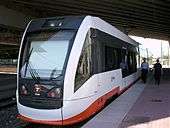
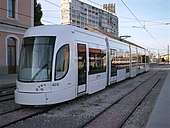
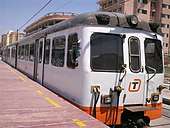
The network comprises the following lines:
| Line | Terminals | Year opened[4] | Service type | Length | Stations | Passengers in 2019[1] |
|---|---|---|---|---|---|---|
| Luceros – Benidorm | 2008 | Tram-train | 44.569 km (27.694 mi) |
20 | 2,579,265 | |
| Luceros – Sant Vicent de Raspeig | 2013 | Tram | 7.207 km (4.478 mi) |
14 | 4,820,667 | |
| Luceros – El Campello | 2003† | Tram-train | 14.404 km (8.950 mi) |
17 | 2,270,646 | |
| Luceros – Pl. La Coruña – Lucentum | 2009 | Tram | 14.609 km (9.078 mi) |
18 | 1,371,854 | |
| Porta de Mar – Pl. La Coruña – Lucentum | 2019 | Tram | 13.285 km (8.255 mi) |
17 | 413,116 | |
| Benidorm – Dénia | 1986† | Regional train | 50.856 km (31.600 mi) |
18 | 635,644 |
† Notes: What is now L3 was opened initially in 1999 as an experimental service between Porta de Mar and Albufereta, and was extended to El Campello in 2003. L9 was originally taken over by FGV in 1986, and was incorporated into the tram network upon its opening.
L1 is a limited-stop service from Alicante city centre to Benidorm taking 70 minutes journey time. In Benidorm it connects with line L9 to Dénia.
L2 starts from the city centre to the General Hospital of Alicante, the University of Alicante and San Vicente del Raspeig, with a journey time of 15 minutes.
L3 is a stopping service from Alicante to El Campello.
L4 runs from the city centre to a loop in Playa de San Juan district.
L5 starts at Porta del Mar to Sangueta, then following the L4 loop in Playa de San Juan district, and was opened in 2019, using former alignment from Porta del Mar and Sangueta that was used prior to the opening of the city centre tunnel to Luceros.[5]
L9 is diesel powered commuter rail service from Benidorm along the coast to Dénia, stopping at other important tourist towns like Altea and Calp. Services are subject to disruption due to engineering works as the line is prepared for electrification.
Lines L1, L2, L3 and L4 share the city centre underground section between MARQ and the city centre Luceros station. The Mercado (Valencian: Mercat) station on the segment was opened on 10 May 2007 and the Luceros was opened on 18 June 2010.
In 2019, the network served 12 million passengers.[1] The busiest stations were Luceros (1,894,496 passengers), Mercado (1,226,471), Benidorm (717,385), Sant Vicent del Raspeig (658,642) and El Campello (558,354).
Future expansion

The underground section is planned to continue westward to Estació Multimodal serving the Adif station (and a possible relocation of the bus station). This was originally delayed, but in March 2019 President of the Valencian Government Ximo Puig committed funds to progress this extension for a 2022-2023 opening.[6]
There are plans to extend the tram-train service southwards to Alicante Airport, El Altet, Elche, Gran Alacant, Santa Pola, Guardamar and Torrevieja. According to the local press it seems unlikely that any of these extensions will be built in the near future due to lack of funds.
Gallery
Underground Stations
Ground Stations
Overpasses and Viaducts
Notes
- Pronunciation:
- Valencian: [ˈtɾam metɾopoliˈta ðalaˈkant].
- Spanish: [ˈtɾam metɾopoliˈtano ðe aliˈkante].
- Local nicknames:
- El Tram (Valencian: [el ˈtɾam], Spanish: [el ˈtɾan]), "The Tram".
References
- "El TRAM de Alicante logra en 2019 un registro histórico con 12 millones de pasajeros". La Crónica Virtual (in Spanish). 21 January 2020. Retrieved 4 April 2020.
- "Alicante: de la diligencia al Tram (la exposición)" (PDF). La Conselleria d'Infraestructures i Transport i Ferrocarrils de la Generalitat Valenciana. 2007. Retrieved 2012-05-28.
- "Alicante en el recuerdo: el tranvía y nuestra ciudad". Alicante Vivo. 2007-07-28. Retrieved 2012-05-28.
- , accessed 3 April 2020
- "New tram connection improves links for Alicante to Porta del Mar and Playa de San Juan". English Radio News. 9 June 2019.
- "Puig anuncia un proyecto de 30 millones para conectar el tranvía y Renfe en cuatro años". Alicante Plaza. 27 March 2019.
External links
| Wikimedia Commons has media related to Trams in Alicante. |
